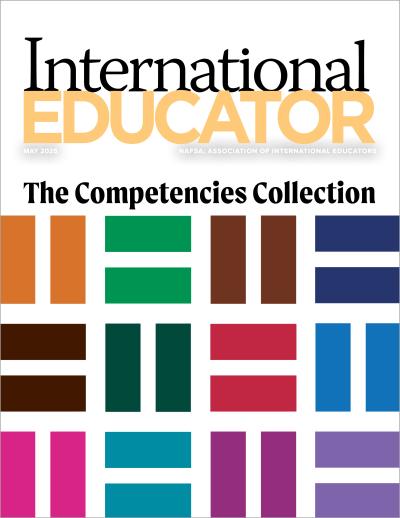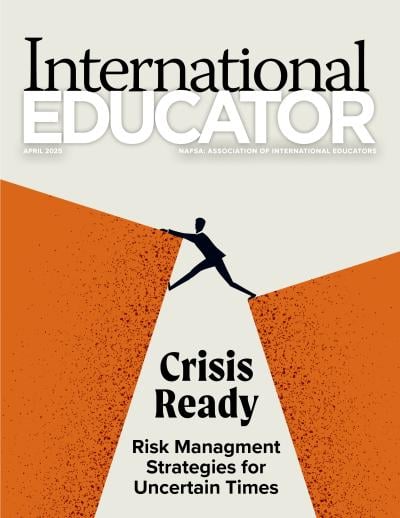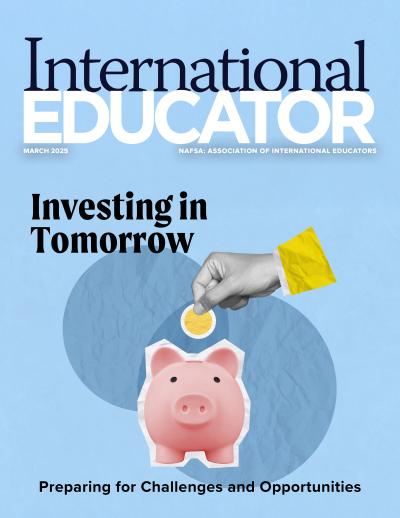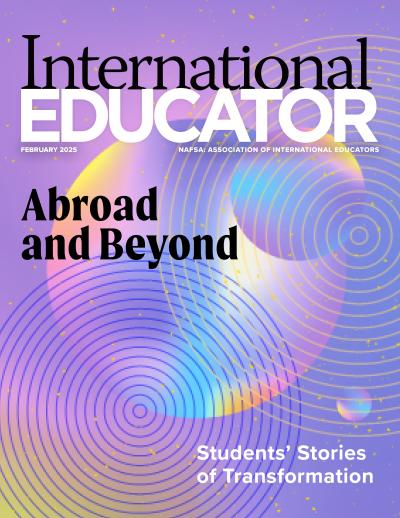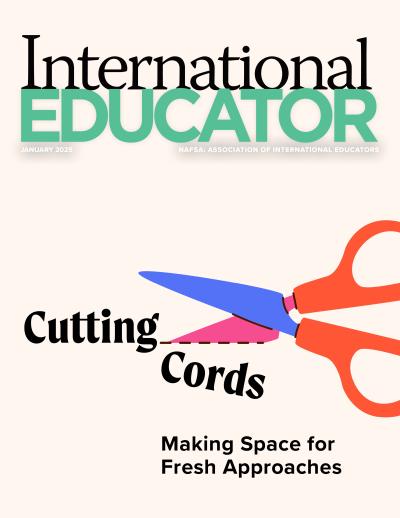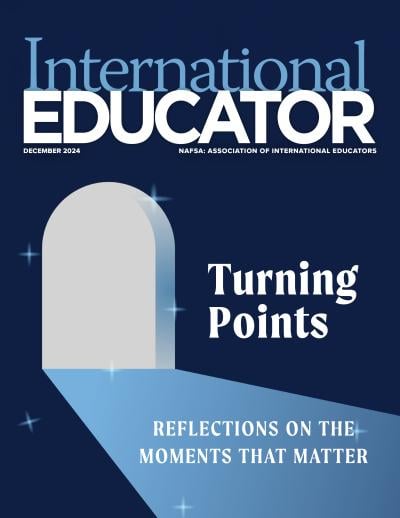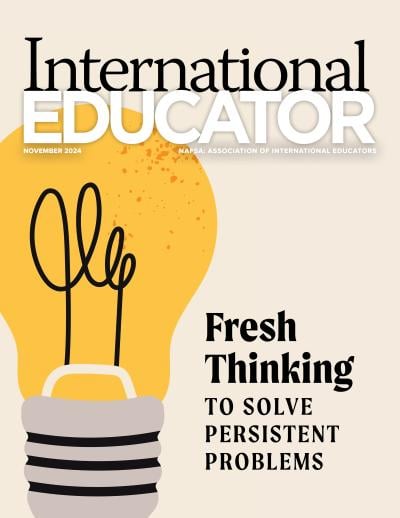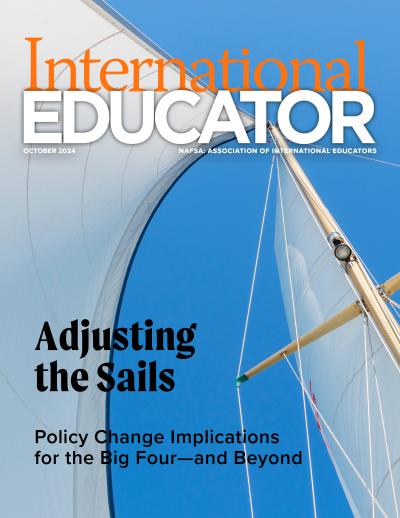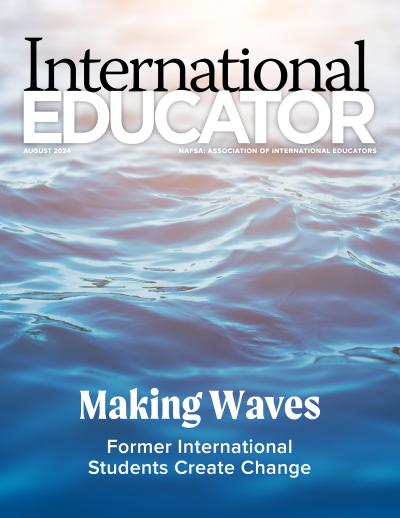Cutting Cords: What International Education Needs to Leave Behind
As a new year begins, it's the perfect time for self-reflection, assessment, and fine-tuning. The axioms that guide this personal growth also hold true on a larger scale: To evolve and thrive, organizations and industries must be willing to reevaluate some common practices and long-held beliefs. Just as growth often requires pruning, progress demands shedding ineffectual approaches to create space for innovation and reinvention.
To explore what international education should leave behind in the coming year, International Educator asked seven professionals where the field could benefit from a critical eye and a willingness to embrace change. Moving on is easier said than done, especially with practices that are deeply ingrained. But as these experts articulate, having the courage to cut cords and streamline may be exactly what international education needs to flourish in the future.
Contributors:
- Dave Anguish, Director, Office of International Students and Scholars, Center for Global Engagement, University of Maryland-Baltimore County
- Markus Badde, CEO, ICEF
- Haviva Parnes, Former Head of Operations, USA, EC English
- Rachel Rui, Director, Office of Global Research, Innovation, and Partnership, Center for Global Engagement University of Tennessee-Knoxville
- Korka Sall, Academic Resident Director, Minnesota Studies in International Development, University of Minnesota
- Sumie Song, Director of Strategic Partnerships, The GREEN Program
- Cesar Wazen, Director, International Affairs Office, Qatar University
Editor’s note: Responses have been edited for length and clarity.
What widely accepted practice or belief in international education should we leave in 2024? What deserves a fresh critical examination?
Dave Anguish:
Elitism in rankings. Something we should leave in 2024 is the elitism inherent in some of the rankings that favor exclusive institutions. These universities tout low acceptance rates and get pats on the back for whom they exclude instead of whom they admit and support on their academic journeys. In other words, what is driving the rankings—inputs or outputs? Research is weighted heavily in most rankings, and the size of an institution has an outsized effect. The raw number of citations seems to matter more than the quality of the research being conducted. Medium-sized research-intensive universities are doing the work, but that’s not reflected in rankings that reward large institutions for their sheer size.
Markus Badde:
Insular thinking. The potential impact of government policies on the international education ecosystem was made crystal clear in 2024. We must think outside our own institutional interests and develop a unified voice that articulates the value of international education to governments, industry, media, and the public. This value has not been well communicated outside of our own industry. It needs to be if we are to avoid future rounds of destructive and ill-informed policies.
Another belief to leave behind is that partners aren’t essential, whether in terms of recruitment, student services, data analysis, or advocacy. International students have more choices and influences—and face more barriers—than ever before. The marketplace is too complex for most institutions to achieve their goals without collaboration. Some combination of agents, in-party representation, third-party service providers, and sectorwide advocacy is needed.
Haviva Parnes:
Mismatched Expectations. I think English-language programs need to accept that students are getting language practice in a variety of ways before they step foot in our schools. The reason [these students] come to the United States is to put that knowledge to practical use and take their learning to the next level. We cannot rely on our traditional models for learning and need to work on including students with a wide variety of motivations. This means embracing shorter-term programs and task-based learning—and developing core competencies as a part of English-language learning.
Korka Sall:
Missed opportunities. The Africa-U.S. relationship needs fresh examination through strategy. Africa has the youngest population in the world, and for many years now, Africans have demonstrated a profound interest in U.S. higher education. It has also been demonstrated many times through studies, data analysis, and reports (by NAFSA, the Institute of International Education, and other organizations) that African students contribute a lot to the U.S. economy. They also positively impact their home countries. African international students are equipped to build a more equitable world and need to be seen as counterparts, not as a burden to the U.S. economy.
Therefore, international educators, U.S. institutions, and African countries need to reevaluate their collaboration and develop more programs, policies, and procedures that support a sustainable relationship.
We need to create more exchange programs via laboratories, Collaborative Online International Learning (COIL), and short-term options that contribute to curriculum internationalization. Now is the time to make the Africa-U.S. relationship a more equitable and sustainable one.
"I strongly believe that the concept of 'global citizenship,' which is at the core of international education, needs to be subjected to a fresh critical examination." —Cesar Wazen
Sumie Song:
Inertia. Institutional inertia is the greatest barrier to advancing sustainability in higher education. While universities and colleges are increasingly prioritizing sustainability, access to courses on sustainability and sustainable development remains limited. In a survey conducted by Students Organizing for Sustainability, 92 percent of college and university students agreed that sustainable development should be “universally taught and promoted." However, only 26 percent of respondents said that sustainable development was covered “in depth” in their coursework, and 40 percent indicated it received little to no attention.
Study abroad can play a critical role in addressing these gaps. A sustainability focus can be incorporated into exchanges that are open to students from different programs. In this way, study abroad can serve as a vehicle for advancing sustainability at an institutional level, ensuring that every student, regardless of major, has the opportunity to learn about sustainability and sustainable development.
Cesar Wazen:
Outdated assumptions. I strongly believe that the concept of “global citizenship,” which is at the core of international education, needs to be subjected to a fresh critical examination. Recently, a lot of surveys have shown that most of the political leaders in the world are either graduates of international programs—mostly in the United States and United Kingdom—or have had some international program experience. Yet, we see a general drift toward the far right in most of the countries around the globe, as these same leaders sometimes champion policies that prevent or limit international student mobility! Global citizenship as we practice it encourages students to view themselves as part of a global community with shared responsibilities, emphasizing values like empathy, tolerance, and respect for diversity. But with the way the world is going, it’s definitely time for a rethink!
Describe a traditional aspect of international programs or initiatives that you believe is no longer serving students effectively.
Anguish:
Lack of intentionality. There’s a tendency to develop programming around what a colleague of mine calls “food, fun, and fashion.” While those are all great things, it can point to a lack of intentionality. Good questions to ask ourselves when developing programming include, “What are the learning outcomes for programming?” and, “Does this align with our goals of supporting student success?” But to avoid any misunderstanding, purposeful programming can—and should—also be fun.
Badde:
Insufficient curiosity. Many institutions lack insight about how prospective international students make decisions about international study and whether current students have the support they really need and want. These insights can lead to better marketing campaigns, more inclusive campuses, and more successful programs. If you aren’t collecting regular feedback from students and agents, it’s time to do so.
Also, if you weren’t investigating the links between your programs and job markets last year, prioritize the effort in 2025. Commit to networking and collaborating with employers. Students are increasingly interested in internships and work placements, and the ability to work during and after studies is directly associated with the perceived value of a program.
"Historically, there has been an emphasis on prioritizing partnerships with high-ranking institutions and overlooking smaller, innovative universities or colleges that could offer unique, meaningful experiences tailored to specific fields or student populations." —Rachel Rui
Parnes:
Overemphasis on long-term programs. Traditionally, there has been a focus on long-term programs and academic preparation, but I think that is changing. We see more and more students looking for English “plus.” In some cases that “plus” is tourism, and in others it is microcredentials. This means that the traditional F-1 route may be changing too. Language schools need to be nimble and prepared to adjust in order to meet market demand.
A good example here is the partnership agreement EC recently signed with the DAVE (Digital Animation and Visual Effects) School in Orlando. Located on the Universal Studios lot, the program provides students with certificates and degrees in things that didn’t exist when I was in university. Community college, certificate programs, shorter-term programs, technology—these are all things that students are more and more interested in, and international programs, including language programs, need to be prepared.
"How do we become more mindful of the impact of our teaching and learning on host communities and countries? How might the ways that we design and deliver programs change if reciprocity were to become a guiding principle?" —Sumie Song
Rachel Rui:
Prestige bias. Historically, there has been an emphasis on prioritizing partnerships with high-ranking institutions and overlooking smaller, innovative universities or colleges that could offer unique, meaningful experiences tailored to specific fields or student populations. Prestigious partnerships can bring the benefit of brand recognition but may not address the full spectrum of student interests. Assessing students' needs and adopting a diversified partnership strategy can broaden the reach and provide more relevant opportunities for students and promote the inclusivity of global learning.
Song:
Extractive practices. How do we become more mindful of the impact of our teaching and learning on host communities and countries? How might the ways that we design and deliver programs change if reciprocity were to become a guiding principle?
At the Green Program, we measure what we value. Using metrics that measure what our partners in Belize call “ethical global learning” encourages us to move away from practices that are extractive and toward those that are mutually beneficial. For example, we prioritize learning that is community integrated, amplifies local knowledge and leadership, and enables partner organizations to build capacity and advance their work. Similarly, we should look at how we go about selecting partners and vendors. When it comes to supplier diversity, for example, are we prioritizing local vendors as well as women- and minority-owned businesses?
What's a common metric for success that you think we should stop using?
Anguish:
Growth metrics. In recruitment and student advising, a single-minded focus on growth can lead to short-term gains, but in the medium and long term, spikes in enrollment can strain resources across an institution. What good is it to yield a huge class of students who will be unsatisfied with their experiences? A better focus is maintaining a sustainable population and investing resources in improved services and outcomes for students.
Badde:
Enrollment targets. For several years, enrollment targets have dominated the conversation. They remain important, but there are many other measures to consider. We need to assess our performance in nurturing students all the way to graduation. International study is a massive investment, and students deserve a top-notch education and experience. A warm welcome is just the start. There must also be systems and initiatives that provide ongoing support, community, campus connections, and career pathways. A major goal should be increasing the number of students who rave about your institution to peers back home because of the positive impact the experience is having on their lives.
There are a range of new metrics that are relevant to our industry, fueled by the sophisticated data we now have access to. Data allow us to discover niche demand, identify ideal candidates for admission, connect programs to labor markets, improve retention, and much more. Data are crucial to improving competitive position, visa approval rates, return on investment, and student satisfaction.
"In recruitment and student advising, a single-minded focus on growth can lead to short-term gains, but in the medium and long term, spikes in enrollment can strain resources across an institution. What good is it to yield a huge class of students who will be unsatisfied with their experiences?" —Dave Anguish
Parnes:
One-size-fits-all definitions of success. I don’t think there’s one thing we need to stop using, but I think we need to personalize what success means. For some of our students, success is passing to the next level; for others, it is getting a specific score on a standardized test; and for some, it is being able to watch movies or television in English. We need to acknowledge that there is not one measure of success for our students, which means the measure of success for our schools is how well we are helping our students achieve their goals, whatever they might be!
Rui:
Mobility numbers. In 2025, it's time to leave behind the overemphasis on student mobility as the sole marker of success in international education. The number of outbound and inbound students has long been used as a primary metric for internationalization. This approach risks overshadowing other high-impact practices that can provide global learning experiences. Initiatives such as virtual exchange, COIL, and curriculum internationalization offer transformative opportunities that are accessible to a broader range of students. These approaches deserve greater recognition and integration into how we define and measure internationalization.
Song:
Participation rates. Study abroad is what the American Association of Colleges and Universities calls a “high impact practice,” an educational strategy that provides “significant educational benefits for students who participate in them–including and especially those from demographic groups historically underserved by higher education.” Participation rates are the metric most commonly used to gauge a program’s success, but we should reevaluate how we’re measuring the impact of exchange programs.
When it comes to sustainability, how are we preparing and positioning students as agents of change who will help create a more resilient, sustainable future? Are we embedding the United Nations Sustainable Development Goals (SDGs) into curricula? Are participants being provided opportunities to learn and practice sustainable principles? Do we work with providers and partners who have sustainability at the core of their mission and operations? What about career readiness? Are we designing curricula that address the knowledge and skills sought by employers, that are project based and solutions focused and that prepare students to tackle real-world issues?
Funding remains the greatest barrier to studying abroad. How are we evaluating strategies for reducing the financial burden on students and families and expanding access to historically underrepresented students?
"We need to personalize what success means....We need to acknowledge that there is not one measure of success for our students, which means the measure of success for our schools is how well we are helping our students achieve their goals, whatever they might be!" —Haviva Parnes
Wazen:
Ranking and reputation. That is an easy one for me. “Ranking and reputation” in global higher education indices should definitely be discarded as a metric for success. The differences in methodology and conception of “internationalization” can yield inaccurate data. And, in some cases, the combination of flawed methodology and malpractices employed by some institutions creates data that are actually misleading. Rankings in the MENA (Middle East and North Africa) region were identified in some surveys as being not only a metric of success but a “driver” for internationalization. A very bad sign!
Describe a policy, regulation, or bureaucratic practice you think hinders operational efficiency or our ability to fulfill our mission and values.
Badde:
Complacency and passive recruitment processes. Many international students now choose to study closer to home, motivated by concerns such as affordability, safety, cultural affinity, and job prospects. Institutions in the “Big Four” destinations—[Australia, Canada, the United Kingdom, and the United States]—are no longer always the first choice. Passive recruitment underpinned by an expectation that the volume of student applications will remain the same or increase is almost certainly doomed to fail.
Be proactive rather than reactive: Partner with vetted agents who have an excellent reputation for professionalism and for focusing on best-fit students. Use customer relationship management systems to boost the work of hardworking marketing and admissions teams. Intuition still matters in recruiting, but it is not enough—not by a long stretch.
"Formal assessments—including TOEFL tests and the GRE—and visa requirements need to be reevaluated to make them more accessible, to better serve students in rural areas and those in difficult living situations. The rigidity of the visa process has become an obstacle to some prospective students who otherwise have all the necessary resources to have a successful U.S. educational experience." —Korka Sall
Parnes:
Overly restrictive employment regulations. We need to allow English-language learners to work while they are studying and not limit this to on-campus work or Optional Practical Training (OPT) and Curricular Practical Training (CPT). Not only could language learners fill some of the hiring needs in a community, but working is an amazing way to practice language skills and use them in a practical setting.
Also, expanded work opportunities create more accessibility. If students can afford to support themselves, they can study longer and at a higher level of intensity—and contribute more to their communities and the overall economy. OPT has a very important place in learning, but I think the value of work—being a barista, bartending, working in retail or the hospitality industry, for example— is undervalued for our students. Work can not only help students learn a language but also build skills to take home and contribute to the global workforce.
"Institutions in the “Big Four” destinations—[Australia, Canada, the United Kingdom, and the United States]—are no longer always the first choice. Passive recruitment underpinned by an expectation that the volume of student applications will remain the same or increase is almost certainly doomed to fail." —Markus Badde
Rui:
Internship restrictions and convoluted processes. Several policies and practices come to mind. First, restrictions on international students' access to essential internships—especially in sectors that require citizenship or extensive clearances—limit the students’ career development opportunities. Advocating for more inclusive internship regulations could open pathways for these students while maintaining compliance with legal requirements.
Second, outdated and convoluted processes—such as those for approving international agreements, enabling student and faculty travel, or processing travel reimbursements—create inefficiencies and can sometimes deter people from participating in global activities. Streamlining these workflows and adopting digital solutions can greatly enhance operational efficiency and encourage engagement. By addressing these barriers, we can create an environment where international students are empowered to contribute to the U.S. workforce and global engagement initiatives drive innovation, collaboration, and economic growth.
Sall:
Rigid approaches to language assessment and onerous visa requirements. We have to find a more sustainable way to assess African students’ language abilities and capacity to have a successful academic journey in the United States. Formal assessments—including TOEFL tests and the GRE—and visa requirements also need to be reevaluated to make them more accessible, to better serve students in rural areas and those in difficult living situations. The rigidity of the visa process has become an obstacle to some prospective students who otherwise have all the necessary resources to have a successful U.S. educational experience.
Training sessions for international educators need to be more effective and include elected officials who enact and administer regulations and policies. Every step and point of contact that international students encounter affects their productivity as well as their ability to see and define themselves in a positive way and to succeed in their studies in the United States.
What's an outdated technology or system that should be phased out?
Anguish:
Email! I know it will never fully disappear, but so many of the things we do over email just don’t make sense. The COVID-19 pandemic provided an opportunity to try out new technologies. We disabled our international student and scholar services email address and implemented an open-source ticketing system that allows students to keep track of their requests without feeling like their message has gone “into the void.” It’s also great for internal auditing, tracking, and accessibility. We also used a live chat system for a while, until we could return to primarily in-person meetings. What experience has taught us is to be wary of relying on any system that makes us feel like we’re working around it. My boss is a proponent of lean management, so to paraphrase Taiichi Ohno, “Let the flow manage the processes, but do not let the processes manage the flow.”
Wazen:
Antiquated technologies and media. We need to phase out paper-based systems and embrace digital tools. By doing this, international education can become more accessible, sustainable, and inclusive, while keeping pace with the expectations of tech-savvy global learners. Cloud-based systems, digital credentialing, application systems powered by artificial intelligence, and learning management systems are a few examples of these tools.
We need to start mastering them—globally mobile students are already way ahead of us and could be discouraged if they still have to go through a 10-page application and a 100-page booklet before applying for an educational opportunity or visa. And marketing teams for international programs also need to explore new social media—the ones potential students use, which we probably don’t know about yet! •
About International Educator
International Educator is NAFSA’s flagship publication and has been published continually since 1990. As a record of the association and the field of international education, IE includes articles on a variety of topics, trends, and issues facing NAFSA members and their work.
From in-depth features to interviews with thought leaders and columns tailored to NAFSA’s knowledge communities, IE provides must-read context and analysis to those working around the globe to advance international education and exchange.
About NAFSA
NAFSA: Association of International Educators is the world's largest nonprofit association dedicated to international education and exchange. NAFSA serves the needs of more than 10,000 members and international educators worldwide at more than 3,500 institutions, in over 150 countries.
NAFSA membership provides you with unmatched access to best-in-class programs, critical updates, and resources to professionalize your practice. Members gain unrivaled opportunities to partner with experienced international education leaders.





